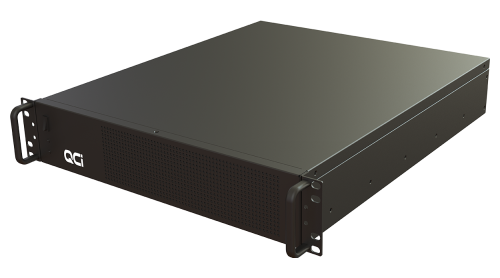Reservoir computing
AI rides on the fast expansion of computing power. Ultimately, it is the data processing speed and capacity that limit how “intelligent” an AI machine can be.
That’s why at QCi we build super-AI systems using hybrid photonic-electronic architectures where photons and electrons work together to push the computing boundaries needed for AI & ML. Photonic computing can be extremely fast and energy efficient, and inherently supports parallel processing at large scale. Yet it is challenging to prepare, interact, and store many photonic signals. Conversely, electronic signals are easy to create and manipulate, but their processing speed and parallelism are heavily capped.

Photonic analog computing for directed AI
What they can do
Our photonic analog computer are purpose built for directed AI.
How it works
Our reservoir computers map input signals into higher dimensional computational spaces through the dynamics of a fixed, non-linear system called a reservoir. After the input signal is fed into the reservoir, which is treated as a "black box," a simple readout mechanism is trained to read the state of the reservoir and convert it to the desired output.
Details
Dive a little deeper into how reservoir computing systems work. To see our research and publications, click here.
Reservoir computing is a framework for computation derived from recurrent neural network theory, which maps input signals into higher dimensional computational spaces through the dynamics of a fixed, non-linear system called a reservoir. After the input signal is fed into the reservoir, which is treated as a "black box," a simple readout mechanism is trained to read the state of the reservoir and convert it to the desired output.
The first key benefit of this framework is that training is performed only at the readout stage, as the reservoir dynamics are fixed.
The second is that the computational power of naturally available systems, both classical and quantum mechanical, can be conveniently utilized to reduce the effective computational cost. It is this advantage and its success on lots of time dependent tasks, such as chaotic time series prediction, radar signal classification, and speech recognition.
Publications
All products are rooted in our scientific publications. To see an exhaustive list of our publications, click here.
Efficient optical reservoir computing for parallel data processing
Efficient reservoir computing using field programmable gate array and electro-optic modulation
Single-pixel pattern recognition with coherent nonlinear optics
Product overview
Summary
Step into unparalleled computation with our high-speed photonic reservoir computer, elegantly housed in a sleek 2U server form factor. At its core is the opto-electronic time delay feedback reservoir, delivering a remarkable 1.25G nodes per second and boasting the capacity for up to 60,000 virtual nodes. This compact powerhouse is tailor-made for intricate time series analysis, proficiently managing everything from real-time data streams to sophisticated temporal pattern recognition. In an era defined by data, our system stands as the embodiment of precision and reliability, setting the benchmark for processing excellence.
Specifications
Dimensions | 530mm x 430mm x 88.6mm |
Weight | 15 kg |
Power requirements | 110VAC |
Typical power consumption | 50W |
Data interface | 10/100/1000 wired ethernet |
Transient response rate | 1.25G nodes/sec |
Number of internal nodes: | up to 60,000 internal nodes |
Summary
QCi’s first reservoir computing product is an edge device that is photonic-inspired, FPGA based, and optimized for recurrent neural network applications. This device has can be applied to solve a variety of problems related to serial data structures including time series prediction, image recognition, and text classification. It’s fast, affordable, energy efficient – and brings the power of a standalone edge computing solution to your desktop.
Specifications
Dimensions | 170 mm x 90 mm x 55 mm |
Weight | 0.6 kg |
Power requirements | USB-C input power control with 45W power adaptor |
Typical power consumption | 10W |
Operating temperature | 0°C to 70°C |
Data interface | 10/100/1000 wired ethernet |
Transient response rate | 10M nodes/sec |
Number of internal nodes | up to 8,192 internal nodes |